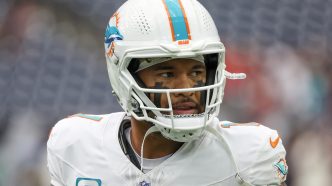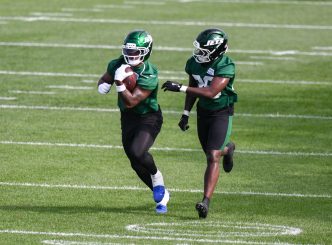As the Miami Dolphins find themselves teetering at 6-8, their playoff chances are dim, resting at just a 5.1% probability. With the postseason practically out of reach, it’s time for some introspection — from the front office down to the players, starting with, of course, the quarterback position.
The Dolphins made headlines with Tua Tagovailoa’s hefty contract extension this summer, a deal that locks in $53.1 million per year with $167 million guaranteed. It was a bold move by Chris Grier and the front office, doubling down on a quarterback in a league where solid starters are gold. Yet, many see this as an overreach, raising eyebrows about whether Tua merited such an investment.
Tagovailoa has shown impressive accuracy, anticipation, a quick release, and a valuable ability to work within Mike McDaniel’s high-octane offense. Still, questions linger about his overall ceiling. It’s tough to admit, but shifting that financial focus to bolster the offensive line or defense might have been wiser. The glaring question remains: Can Tua steer this team to a Super Bowl victory, or even lead a deep playoff run? So far, the results in crucial games haven’t answered this positively.
Beyond that notorious Texans game, Tagovailoa’s challenges in the pocket — his limited arm strength and inconsistent offense leadership — stand out. These weaknesses have been evident enough for opponents to exploit them efficiently. The Dolphins’ struggles against a cover-two zone, faced more frequently than any other team at 26% of opponent plays, highlight this issue.
Meanwhile, the team’s strategic embrace of speed under Chris Grier and Mike McDaniel appears increasingly unsustainable. Despite their explosive play potential, the Dolphins’ ground game is struggling, averaging below four yards per rush. The dynamic outside-zone rushing success of last season seems like a distant memory. Opponents have deciphered the code to counter McDaniel’s offensive schemes, leaving the unit ranked 24th in scoring and 31st in rushing efficiency — a steep fall from their previous top-five EPA per play.
On the defensive front, though, there’s a silver lining. Under first-year coordinator Anthony Weaver, the team has allowed the 13th-fewest points this season. Rookies like Chop Robinson show promise, and despite losing Christian Wilkins, stalwarts like Zach Sieler and Calais Campbell have anchored the defensive line admirably.
Yet, the Dolphins’ veteran stars — Jalen Ramsey, Tyreek Hill, and Terron Armstead — are racing against time, with aging being an inevitable adversary even as they maintain high performance levels.
Chris Grier indeed deserves applause for some savvy trades and roster constructions, but his tendency to double down on speed — drafting speedsters Jaylen Wright, Malik Washington, and Tahj Washington in the same year — seems overindulgent. When does relentless commitment to speed morph from strategic to shortsighted? Perhaps that pivot point is now.
As the Dolphins assess their current position, fundamental questions about long-term strategy and execution demand honest answers, shaping the decisions needed to steer the franchise back to a competitive future.








